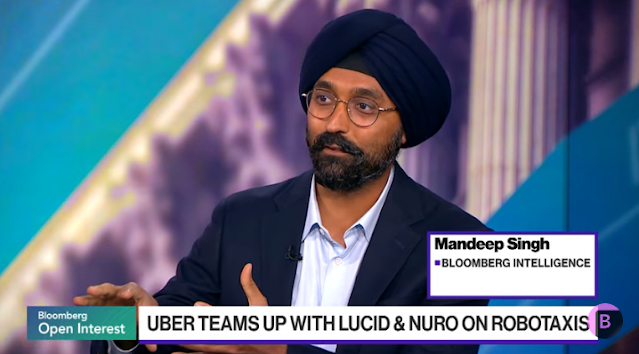Key Takeaways
- Uber commits to buying 20,000 Lucid Gravity SUVs equipped with Nuro’s Level 4 autonomous tech over six years, starting in 2026 .
- $300 million investment in Lucid anchors the deal, with additional “multi-hundred-million” funding for Nuro .
- First commercial launch targets a major U.S. city in late 2026, with prototype testing underway in Las Vegas .
- Lucid’s 450-mile range and redundant systems enable high vehicle utilization, reducing downtime .
- Nuro pivots from delivery bots to AV licensing, securing its largest commercial deal to date .
The $300 Million Handshake: Uber, Lucid, and Nuro Forge Robotaxi Future
Uber just dropped a massive bet on driverless rides. Announced today, they’re pouring $300 million directly into Lucid and another undisclosed (but larger) chunk into self-driving startup Nuro. This ain't just cash though—it’s a binding promise to deploy 20,000+ electric robotaxis over six years. These won't be generic AVs; they’re Lucid’s premium Gravity SUV stuffed with Nuro’s “Level 4 Driver” tech, built exclusively for Uber’s platform. First city launch? Sometime next year. It’s Uber’s boldest move since ditching its own AV unit back in 2020 .
What’s really stickin’ out here is the scale. Twenty thousand vehicles ain’t incremental—it’s industrial. Waymo, today’s AV leader, operates about 1,500 cars total. Tesla’s Austin pilot? A dozen Model Ys. Uber’s play signals a serious pivot from partnerships (like its existing Waymo tie-up) to controlling its own AV destiny .
Why Lucid’s Gravity SUV Became Uber’s Robotaxi Pick
Lucid wasn’t an obvious choice. They’re a luxury EV maker with modest sales—just 3,309 vehicles last quarter. But their tech fit Uber’s needs cold. The Gravity SUV’s 450-mile range means less downtime charging, critical for ride-hail economics. Its fully redundant systems (brakes, steering, sensors) meet the safety demands of driverless ops. And Uber’s cash infusion gives Lucid immediate scale; those 20,000 orders nearly match Lucid’s entire 2025 delivery goal .
Lucid’s interim CEO, Marc Winterhoff, stressed this validates their tech beyond consumer EVs: “We’ve been chosen because of our EV technology leadership.” Translation: Uber’s stamp of approval could pry open fleet markets globally. With Lucid’s stock soaring 30%+ on the news, investors clearly agree .
Nuro’s Pivot Pays Off: From Delivery Bots to Robotaxi Brains
Nuro’s had a wild ride. Founded by ex-Waymo engineers, they spent years building cute, low-speed delivery pods for pizzas and groceries. But last year, facing cash burns and layoffs, they pivoted hard: ditch the bots, license the AI. This Uber deal is their first mega-validation. Nuro’s “Level 4 Driver” system—tested over 1M autonomous miles—will handle perception, navigation, and safety for the Lucid fleet .
Dave Ferguson, Nuro’s president, called integration “almost a delight” due to Lucid’s pre-wired architecture. Their prototype? Built in just seven weeks. Now, with Uber’s deep pockets and global reach, Nuro leapfrogs into the AV big leagues .
Inside the Robotaxi: Range, Redundancy & Rider Experience
So what makes this trio’s tech stack special?
- Hardware: Sensors, compute, and backup systems (like dual steering controls) installed directly on Lucid’s assembly line—no retrofits .
- Software: Nuro’s AI model uses “end-to-end” learning, aiming to adapt faster to new cities than rivals .
- Range: Lucid’s 450-mile EPA rating allows ~2 days of urban driving per charge. Huge for profitability .
- Safety: Nuro will validate performance across “dozens of categories” via simulation and real-world tests .
Uber’s app will handle booking and fleet management. Riders should expect premium pricing—think Uber Black—given the Gravity’s luxury roots .
Testing Timeline: Where, When, and How
Right now, a functional prototype is navigating Nuro’s closed track in Las Vegas. Next phase? Supervised street testing in 2025. If regulators agree, the first commercial service launches in one major U.S. city (unnamed) in late 2026. Uber’s betting Nuro’s methodical rollout—contrasted with Tesla’s “beta” approach—will smooth regulatory approvals .
Table: Robotaxi Deployment Timeline
Robotaxi Wars: Uber vs. Waymo, Tesla, and Zoox
Uber’s not alone chasing driverless dreams. Here’s how rivals stack up:
- Waymo: Uber’s current partner in Phoenix/Austin, operates ~1,500 Jaguar I-PACE robotaxis. Cautious expansion.
- Tesla: Testing ~12 Model Ys in Austin with safety drivers. Musk promises rapid scaling (unverified).
- Zoox: Amazon’s boxy robotaxi targets Las Vegas launch this year .
Uber’s edge? Existing global demand. With 34 million daily trips, funneling even 1% to Lucid-Nuro taxis creates instant scale. Their asset-light model—Uber or partners own the fleet—also avoids Waymo’s capital strain .
Hurdles Ahead: Regulations, Costs, and Public Trust
Let’s not sugarcoat—this is risky. Autonomous vehicles still face:
- Regulatory Scrutiny: Nuro needs new state permits despite past delivery licenses .
- High Costs: Each Lucid Gravity starts at $79,900. Add autonomy hardware, and per-vehicle costs likely top $100K.
- Safety Skepticism: GM’s Cruise shutdown after a pedestrian incident shows how fast public trust crumbles .
Uber’s betting that partnering with specialists (Lucid for EVs, Nuro for AI) de-risks execution. If they nail the first city rollout, the blueprint goes global .
FAQs: Uber, Lucid, and Nuro’s Robotaxi Deal
Q: When can I ride in a Lucid-Nuro robotaxi?
A: Late 2026 in one initial U.S. city. Expansion to other markets follows through 2032 .
Q: Are these truly driverless?
A: Yes. Nuro’s Level 4 system operates without human backup in mapped zones under normal conditions .
Q: What happens to Uber drivers?
A: Uber insists human drivers remain essential for “at least the next decade.” Robotaxis will complement, not replace them initially .
Q: How will safety be verified?
A: Nuro must prove safety via simulated and real-world scenarios across dozens of risk categories before launch .
Q: Why did Uber choose Lucid over Tesla or Ford?
A: Lucid’s long range, redundant systems, and luxury fit aligned with Uber’s premium service goals .



Comments
Post a Comment